Table of Contents
Picture a lush, green lawn on your California property – it’s easier than you think! Our month-by-month lawn care calendar makes it all very simple. Whether you’re a seasoned gardener or just starting, you’ll find practical tips for every season, from aeration to pest control to general cleanup.
Key Takeaways
- Spring: Tackle basic upkeep. Clear debris, mow to 3 inches, and water in the morning. Use fertilizer to boost nutrients and stay ahead of pests and diseases.
- Summer: Keep up with mowing and water wisely. Watch for signs of drought and stay consistent with fertilizing and managing pests and diseases.
- Fall: Prepare for the colder months. Remove leaves, apply fertilizer for winter, and monitor pest and disease activity.
- Winter: Focus on maintaining your lawn against the cold. Manage snow and leaves, water as necessary, and use winter fertilizer to protect your grass.
Spring
March
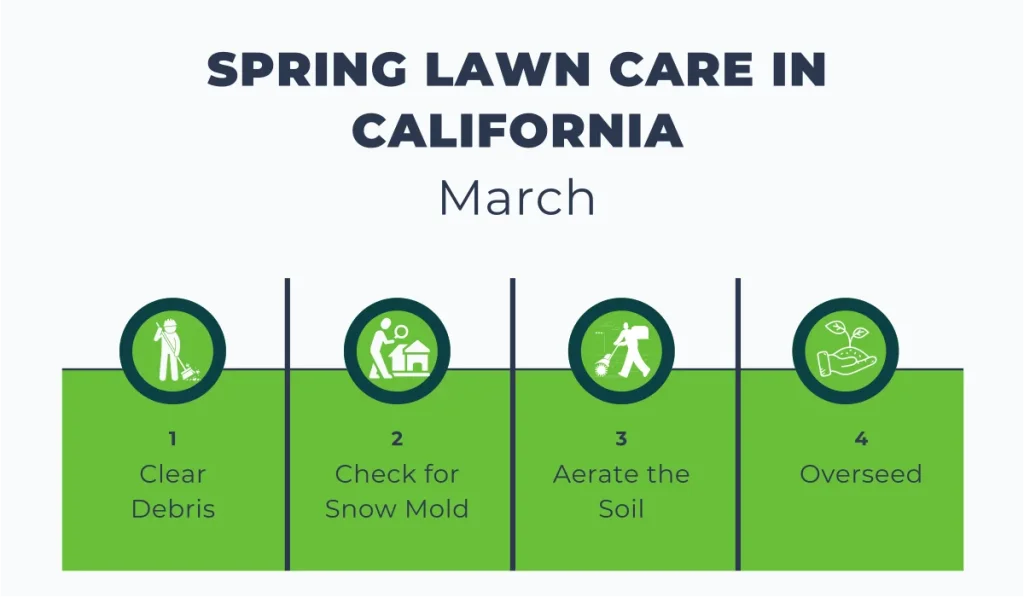
In March, as winter gives way to early spring, it’s essential to prepare your lawn for the growing season:
- Clear Debris: Remove leaves, twigs, grass clippings (or mulch them), and other debris to let sunlight reach the grassroots, encouraging new growth.
- Check for Snow Mold: Inspect for snow mold and gently rake affected areas to prevent it from spreading.
- Aerate the Soil: If the soil is compacted, aerate it. This process involves making small holes in the soil, allowing air, water, and nutrients to penetrate deeper, promoting robust root growth and preventing compaction.
- Overseed: Consider overseeding to fill in bare patches, improve turf density, and enhance overall lawn health.
These steps set the foundation for a season of growth, helping your lawn emerge strong and vibrant as spring progresses.
April
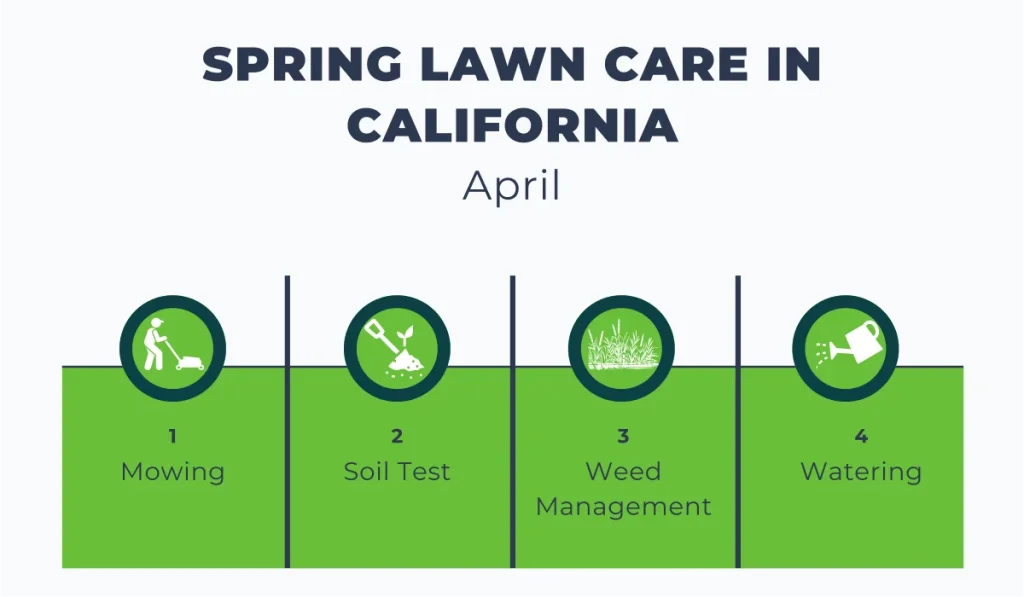
In April, your lawn enters a period of active growth. Here are the essential tasks for this month:
- Mowing: Begin regular mowing. Keep mower blades sharp and set the height between 2.5 to 3 inches, particularly for cool-season grasses. Aim to trim no more than 1/3 of the grass blade to maintain lawn health.
- Soil Test: Conduct a soil test to help assess pH levels and nutrient content. Adjust soil acidity with slow-release lime or alkalinity with sulfur as needed.
- Weed Management: It’s time to control weeds. Apply pre-emergent herbicides for early prevention, especially for dealing with crabgrass. Use post-emergent herbicides for visible broadleaf weeds.
- Watering: Ensure your lawn gets about 1 ½ – 2 inches of water per week, including rainfall. Morning watering is most effective for reducing evaporation and maximizing moisture absorption.
Focusing on these areas in April sets the stage for robust lawn growth as spring moves forward.
May
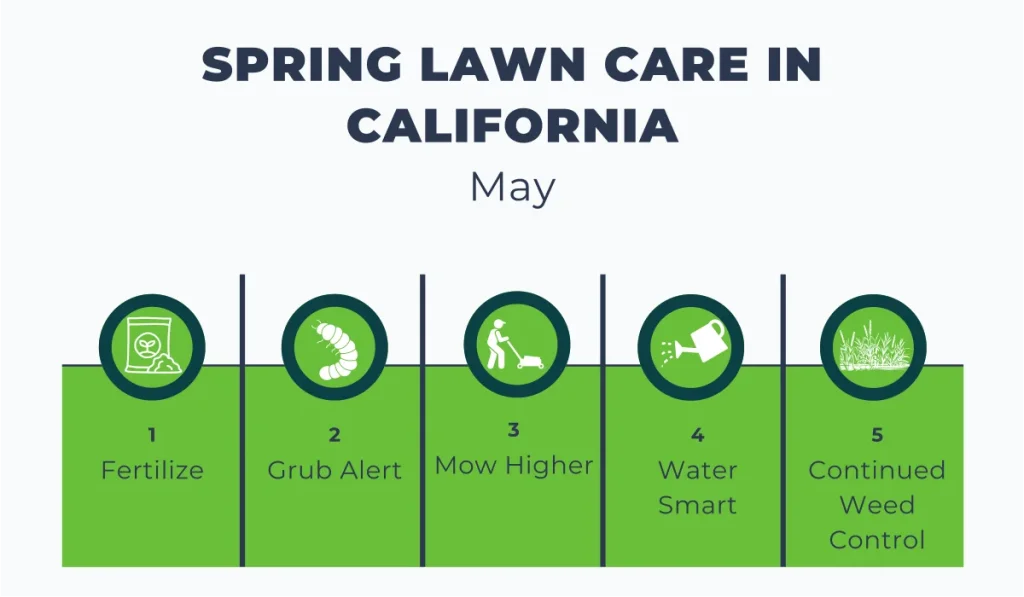
May marks a pivotal time for lawn care as rising temperatures and longer days accelerate growth. This month, it’s vital to adapt your routine to nurture and protect your lawn during this active phase:
- Fertilize: Use a nitrogen-heavy, slow-release type for continuous nourishment.
- Grub Alert: Spot brown patches? Apply insecticide or natural methods to remove grubs.
- Mow Higher: Increase blade height for better heat and drought resistance.
- Water Smart: 1 ½ to 2 inches per week, more in heat, and always in the morning.
- Continued Weed Control: Continue with post-emergent herbicide treatments as needed. Timely application of weed killer is crucial to control weed growth and prevent spreading.
Remember, the type of fertilizer and your watering schedule will influence how often you need to fertilize. Quick-release fertilizers should be reapplied every 4-6 weeks, while slow-release types can be reapplied every 6-8 weeks. Keep this in mind whenever you add fertilizer throughout the year.
Summer
June
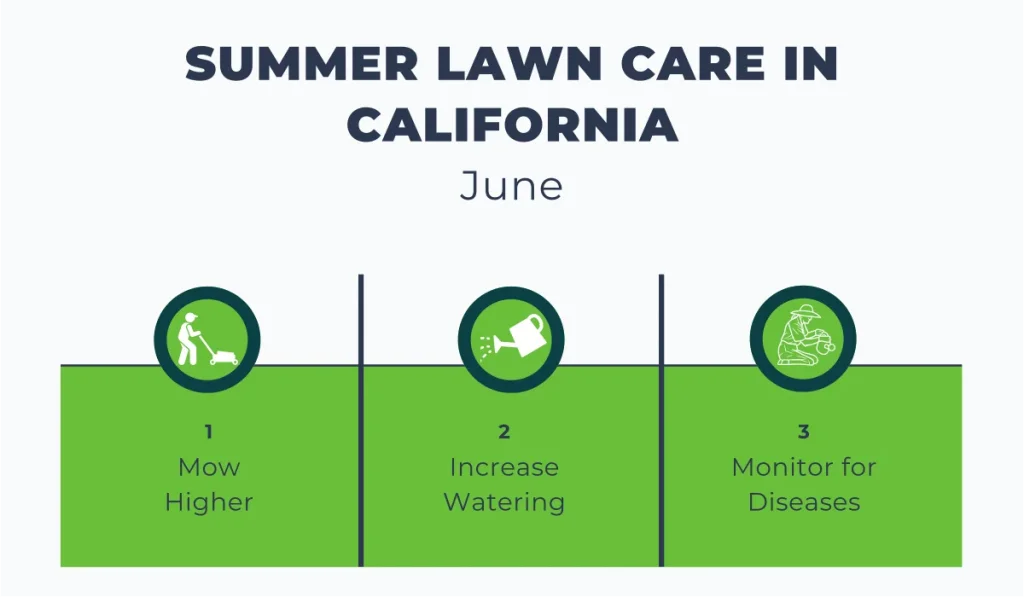
June heralds the onset of your summer lawn, calling for tailored lawn care strategies:
- Mow Higher: Increase mower height to 3-4 inches. This helps shade the soil and reduce evaporation while controlling weeds.
- Increase Watering: Aim for 1.5 inches of water per week, split into two sessions. Check the soil moisture with the screwdriver test.
- Monitor for Diseases: Watch for signs like leaf spots or discoloration, using fungicides as necessary.
Focus on regular mowing, sufficient watering, and disease management to keep your lawn robust during the summer heat. Avoid heavy tasks like fertilization or aeration.
July

July, the heart of summer, brings heat and potential drought, requiring diligent lawn maintenance:
- Mow Tall: Continue at 3 to 4 inches to shade the soil and reduce evaporation. Regular mowing with sharp blades is vital.
- Water Deeply: Aim for 1.5 to 2 inches per week in two or three sessions. Water early to minimize evaporation.
- Heat Stress Alert: Watch for wilting or a blue-gray tint. Water immediately if these signs appear. Adjust for droughts ahead of time.
- Pest and Disease Control: Look out for chinch bugs, sod webworms, and signs of brown patch or dollar spot. Use appropriate insecticides or fungicides as needed.
In July, focus on supporting your lawn through the heat with adequate watering, regular mowing, and close monitoring.
August
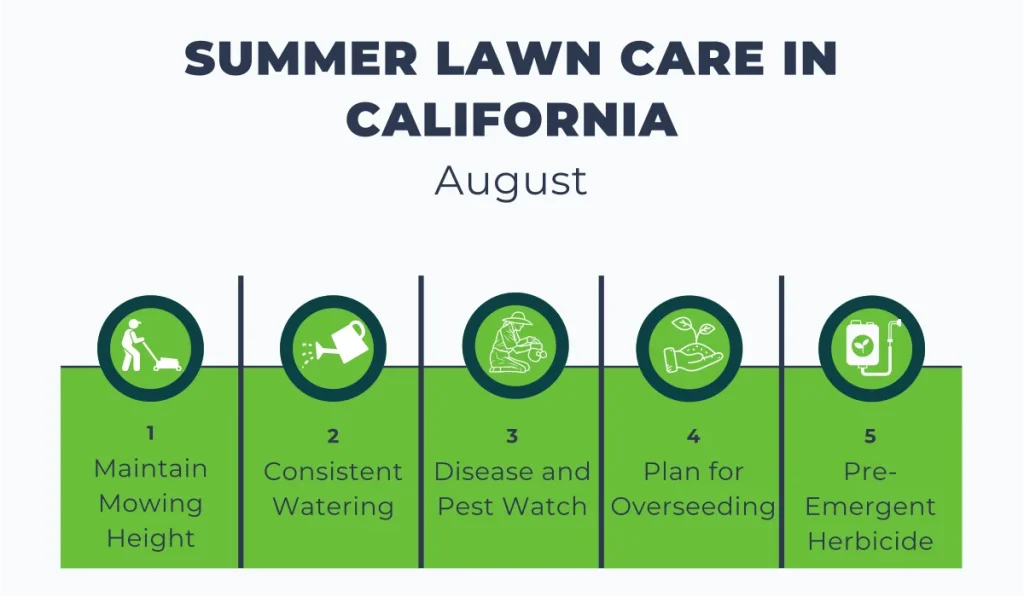
August, the final stretch of the hot summer, presents unique lawn care needs:
- Maintain Mowing Height: Keep grass at 3 to 4 inches for shade and moisture retention.
- Consistent Watering: Continue with 1.5 to 2 inches of water per week in two to three sessions, preferably in the morning.
- Disease and Pest Watch: Regularly inspect for signs like discoloration or insects. Act quickly with the right treatments if issues arise.
- Plan for Overseeding: Prepare for overseeding by late August, gathering seeds and supplies for early fall application.
- Pre-Emergent Herbicide: Late August is the time to apply pre-emergent herbicide to prevent winter weeds. This step is essential for maintaining a weed-free lawn throughout the cooler months.
In August, focus on supporting your lawn through summer’s end with attentive watering, mowing, monitoring, and overseeding preparations. Avoid heavy tasks like fertilization or aeration during this time.
Fall
September
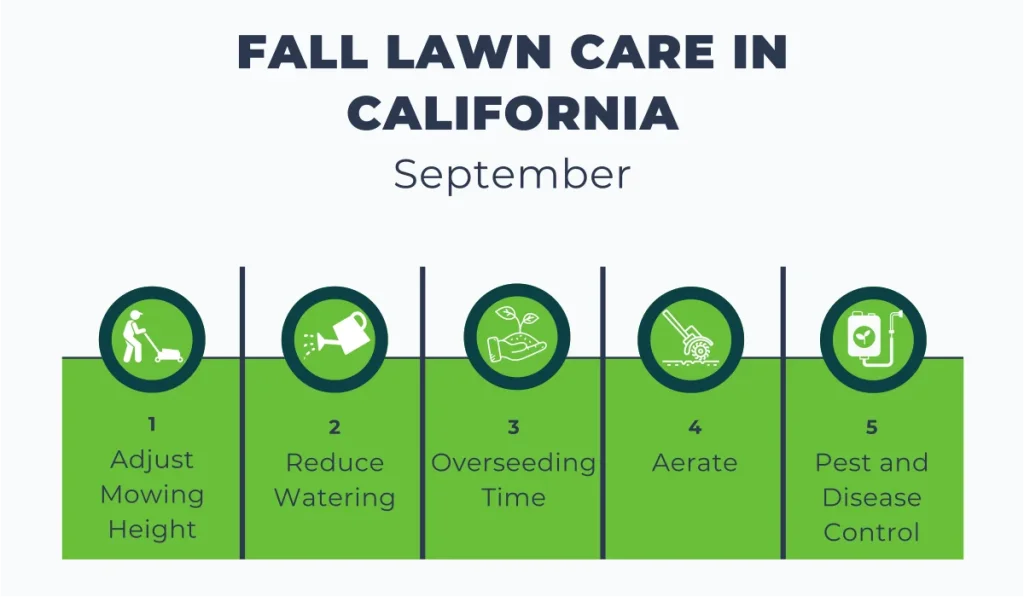
September marks the transition to fall, bringing pivotal changes in lawn care:
- Adjust Mowing Height: Lower the mowing height to 2 to 2.5 inches to prevent leaf mold and disease.
- Reduce Watering: Decrease water consumption to about 1 inch per week, adjusting for dry conditions if necessary.
- Overseeding Time: Ideal for filling in thin areas and improving density. Mow slightly shorter, rake out thatch, then evenly spread new seed.
- Aerate: Enhance soil health by aerating this month. This helps with water, oxygen, and nutrient absorption.
- Pest and Disease Control: Look for any signs of infestation or disease and treat promptly.
In September, your lawn care focus shifts from managing summer heat to preparing for cooler weather, setting the stage for a resilient and healthy lawn.
October
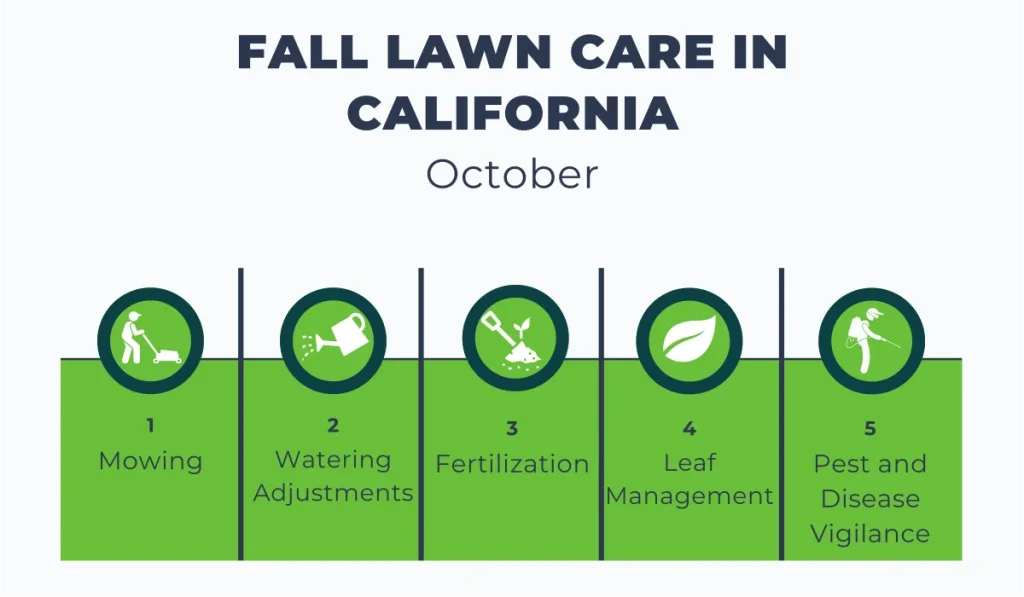
October, nestled in the heart of fall, continues the shift in lawn care focus:
- Mowing: As grass growth slows, reduce mowing frequency but maintain around 2 inches in height. Sharp blades are essential for clean cuts.
- Watering Adjustments: Aim for about 1 inch of water per week, modifying for local weather conditions. Deep, early morning watering is most effective.
- Fertilization: Apply a slow-release, granular fertilizer to nourish your lawn for winter. Follow package instructions for optimal results.
- Leaf Management: Regularly clear leaves to prevent mold and disease. If possible, mulch them into the lawn for natural nutrient recycling.
- Pest and Disease Vigilance: Watch for and promptly treat any signs of pests or diseases.
In October, your lawn care efforts are geared towards preparing your grass for the winter months while maintaining its health and appearance.
November
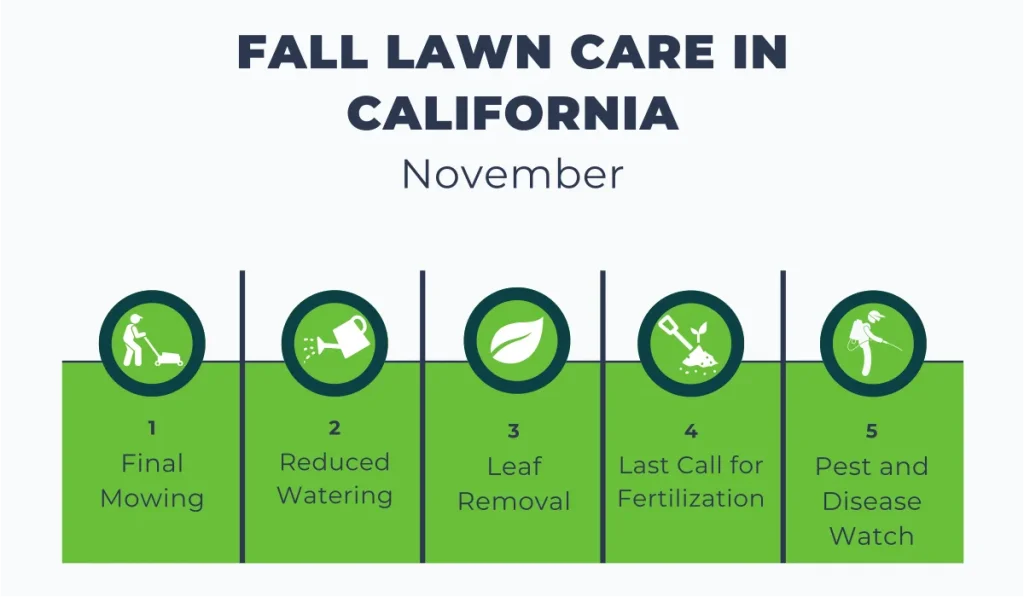
As November ushers in cooler temperatures, lawn care shifts to winter preparation:
- Final Mowing: Continue mowing until growth stops, lowering the blade to about 2 inches for the last cut. This helps prevent snow mold in winter.
- Reduced Watering: Watering needs may lessen with natural precipitation, but in dry conditions, maintain about 1 inch per week until freeze.
- Leaf Removal: Keep raking leaves to prevent blocking light and trapping moisture, which could lead to lawn diseases.
- Last Call for Fertilization: If not done in October, apply a winterizing fertilizer now to strengthen roots and boost nutrient reserves.
- Pest and Disease Watch: Stay alert for any signs and treat as needed, ensuring your lawn remains healthy.
November’s lawn care is about setting a solid foundation for your lawn to withstand winter and rebound beautifully in spring.
Winter
December
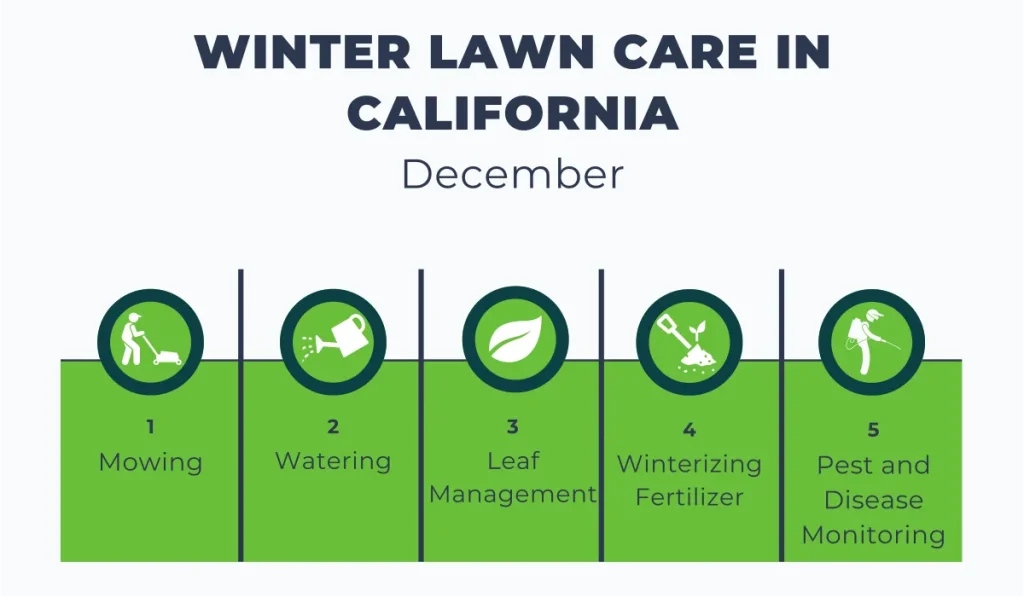
December’s arrival marks a shift in lawn care focus to maintenance and preparation for the winter:
- Mowing: If grass grows, mow as needed, maintaining a blade height of around 2 inches.
- Watering: Generally reduced due to natural precipitation. In a dry winter, water until the ground freezes.
- Leaf Management: Continue to clear fallen leaves to prevent light blockage and moisture trapping, which can cause diseases.
- Winterizing Fertilizer: Apply now if you still need to and the ground isn’t frozen to fortify your lawn for winter.
- Pest and Disease Monitoring: Stay vigilant for active pests or diseases, treating them as necessary.
Your lawn care in December is about setting the stage for your lawn to endure the winter and flourish in the coming spring. How often you water grass in winter depends on some factors, though.
January
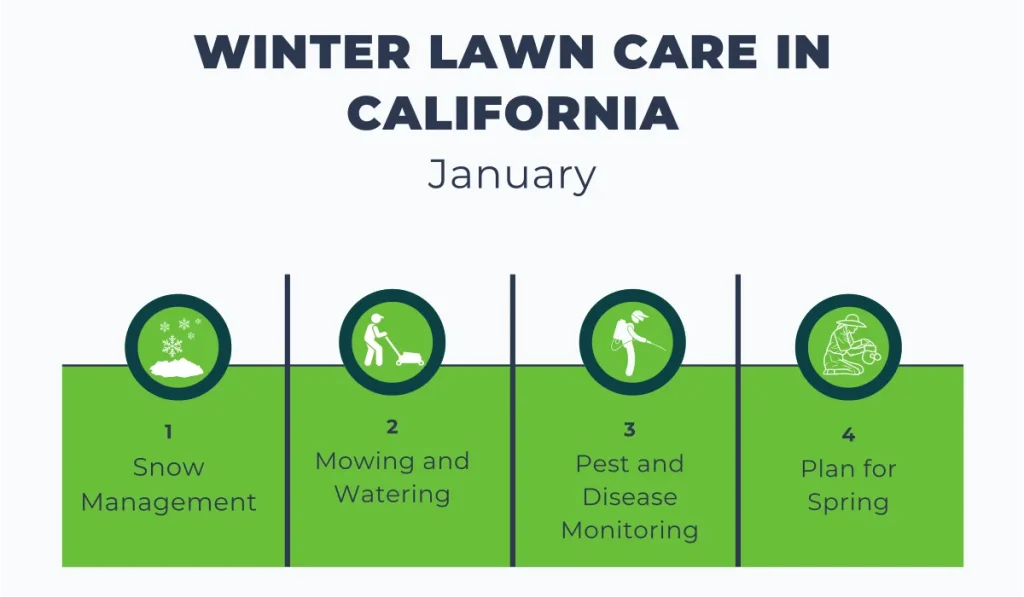
In the heart of winter, January’s lawn care focuses on protection and preparation:
- Snow Management: If heavy snowfall occurs, evenly remove snow to prevent snow mold and protect the grass. Use non-metal tools to avoid damaging the turf.
- Mowing and Watering: If the grass grows during this winter weather, continue mowing at 2 inches. Watering is usually unnecessary, but keep the lawn hydrated in dry conditions.
- Pest and Disease Monitoring: Stay alert for active pests like grubs and signs of disease, treating any issues promptly.
- Plan for Spring: Use this quieter period to strategize for spring lawn care. Reflect on the past year’s successes and challenges to refine your approach.
January is about safeguarding your lawn during dormancy and laying the groundwork for a vibrant spring.
February
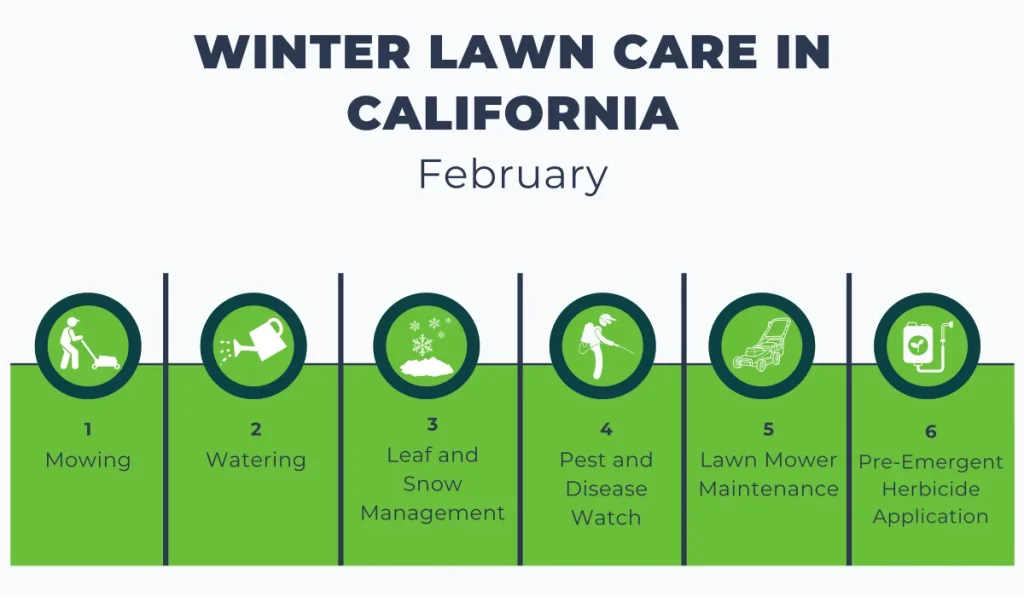
As winter begins to wane in February, there are still important lawn care activities to attend to:
- Mowing: If in a mild winter climate with ongoing grass growth, continue mowing at a height of about 2 inches.
- Watering: Generally, winter precipitation suffices, but in dry conditions, water the lawn lightly, aiming for an inch per week.
- Leaf and Snow Management: Keep clearing any fallen leaves and evenly distribute snow to prevent mold and grass damage. Avoid metal shovels to protect the turf.
- Pest and Disease Watch: Remain vigilant for pests like grubs or any signs of lawn disease, treating them as necessary to maintain lawn health.
- Lawn Mower Maintenance: Use this time to service your lawn mower – sharpen blades, change the oil, and check the air filter.
- Pre-Emergent Herbicide Application: Mid-February to early March is ideal for applying pre-emergent herbicide. This step is crucial for preventing summer weed growth.
Dedication to lawn care in February lays the groundwork for a thriving lawn in spring. This is the time to prepare, ensuring everything is ready for the warmer months ahead.



